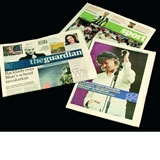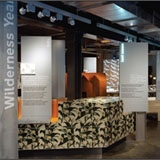Starck times at the awards
After the relaunch of the D&AD Global Awards, Mike Exon asks what’s next for the non-profit organisation

After the relaunch of the D&AD Global Awards, Mike Exon asks what’s next for the non-profit organisation.
Was it me, or did design work fail to make a dent on this year’s D&AD awards? With a few honourable exceptions, like The Guardian design team’s best of show, it felt like there was a paucity of significant design projects among the Yellow and Black Pencils. Not even Philippe Starck’s President’s Award was able to mask the fact that 2005 was not the year of mindblowing design work from the house of D&AD.
Blurry-eyed designers at The Partners, Nick Bell Design, Land Design, More4, Teresa Roviras Design, De Matos Storey Ryan and 6a Architects will disagree with me, I guess, as will its design land president Dick Powell, who has been at the helm now for a valiant 20 months. But where was branding (no nominations), where was graphic design (well done Wieden & Kennedy UK), where was digital media (Peter Higgins stop waving) and what about product design (we already know Apple rocks the world)? Perhaps the impressive slew of media and publishing winners – Grazia, The Guardian, New York Magazine, Marmalade Magazine, M-Real Magazine – gives us a taste of just where some creative talent is emerging from, but the future of media is not in print alone.
The D&AD awards have traditionally been the annual pinnacle of interdisciplinary, commercially creative excellence. Relaunched this year as the D&AD Global Awards, a move designed to reflect the fact that over 70 per cent of entries are now non-UK, the D&AD awards is still the Turner Prize of the creative industries – love it or hate it, you still want to know who has won.
As an organisation, the D&AD has successfully become a whole lot more than the annual awards scheme that crowns its four-week summer Congress. As well as building international initiatives in education and professional development – which is no mean feat given various attempts by other creative organisations – the charity is also going regional in a big way. Next month effectively sees the inauguration of its newest initiative, D&AD North-West, with a month-long public exhibition at Urbis in Manchester called The Best Design and Advertising in the World.
In the hot seat for approaching four years now, its chief executive Michael Hockney is well aware that this extrapolation to the regions comes not before time.
‘We’ve been very London-centric,’ acknowledges Hockney. ‘This meant that there were lots of creatives who never felt able to integrate into D&AD. We went into the North-West because there is a thriving community of talent there, as well as a ready-made chairman in the guise of Ben Casey from The Chase.’
The plan, says Hockney, is to launch other regional hubs in the UK over the coming months. Since announcing the North-West initiative, Hockney says he has held productive meetings with a number of other very switched on Regional Development Agencies, though he declines to name them.
‘I think it’s safe to say that come September we’ll be in a position to announce our next regional hub,’ he says.
Clearly geographical devolution is not the only change the organisation is addressing. Adopting the poly-central model may allow D&AD to expand its reach into the regions and overseas, but, as it broadens its scope on terra firma, it also needs to have a clear vision of the creative disciplines that will produce the talent of the future.
Some would say that’s not so easy for those who are above-the-line trained at the classical school. So what does Hockney say to the cynics who accuse D&AD of being heavily biased towards the traditional advertising and media community?
‘I don’t think that’s true of D&AD at all,’ he says. ‘Of course, the ad agencies are prominent because of their relative size, but, in terms of our representation, it’s genuinely across the board. I think that nowadays there is much more appreciation and respect between disciplines and that’s encouraging.’

To the organisation’s credit, you only have to look at what’s been happening with the bigger D&AD brand to see the strategic direction the organisation is taking. Slowly it has sought to offload a stuffy reputation for propping up the darlings of advertising and design, and connect with a younger generation working in a whole new way.
Dropping the ‘Design and Art Direction’ moniker sought to move it away from simply an advertising-design gig. Dropping the ‘British’ prefix introduced by Mary Lewis moves it offshore.
For designers, the bigger question is what will happen to the Fletcher Forbes Gill marque when it is relaunched in September? The word is that beefing up the iconic visual identity will be the clearest sign yet of an intent to progress.
D&AD Winners selection 2006:
Black Pencils
• The Guardian design team for the relaunch of the paper
• Leo Burnett Canada for Big Ideas Come Out of Little Pencils
Yellow Pencils
• The Partners for Casa Loreto Olive Oil
• Land Design Studio for UK World Expo Pavilion
• Nick Bell Design for the Churchill Museum
• Channel 4 for Iraq: The Bloody Circus
• Apple Computer for iPod Nano
• Emap design team for Grazia
• John Brown Citrus for M-Real Magazine
• New York Magazine for Sex
• Bascule for Bascule site
• Teresa Roviras Design for Daylesford Organic
• Marmalade Magazine for F**k Art, Let’s Dance
• Sigi Mayer for Anton Riepi Meat Co
• Wieden & Kennedy for Christmas Pudding graphics
• 6a Architects for Hairywood
• De Matos Storey Ryan for Durham Bird Boxes
D&AD: The Best Design and Advertising in the World takes place at Urbis, Cathedral Gardens, Manchester M4 3BG, from 27 May to 2 July
-
Post a comment




